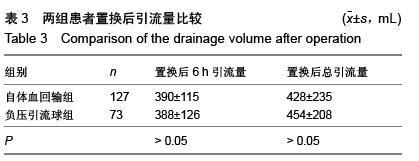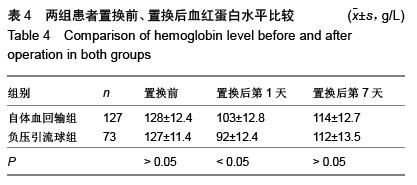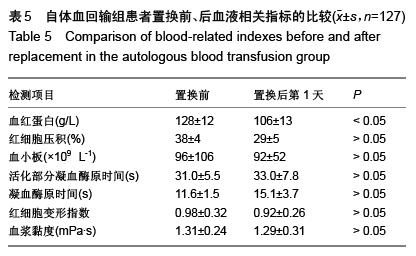| [1] Catling S. Blood conservation techniques in obstetrics:a UK perspective. Int J Obstet Anesth. 2007;16(3):241.[2] Prins HA,Houdijk AP,Nijveldt RJ,et al. Arginase release from red blood cells:possible link in transfusion induced immune suppression? Shock. 2001;16(2):113.[3] 许承斌,柴晓文,李剑.4项传染病指标在患者输血或手术前的检测分析[J]. 重庆医学,2009,38(16):2119.[4] Lee YC, Park SJ, Kim JS, et al. Effect of tranexamic acid on reducing postoperative blood loss in combined hypotensive epidural anesthesia and general anesthesia for total hip replacement. J Clin Anesth. 2013;25:393-398.[5] Borghi B, Borghi R. Blood-saving techniques. Transplant Proc.2011;43:333-337.[6] 张先龙,何耀华,王琦,等.后路小切口人工全髋关节置换术[J].中华创伤杂志,2005,21(8):591.[7] Yang C,Zhu Q,Han YS,et al.Minimally-invasive total hip arthroplasty will improve early postoperative outcomes:a prospective,randomized,controlled trial. Irish J Med Sci. 2010.179(2):285-290.[8] Bochicchio GV, Napolitano L, Joshi M, et al. Outcome analysis of blood product transfusion in trauma patients: a prospective, risk-adjusted study. World J Surg. 2008;32(10): 2185-2189.[9] 徐涛,王佳,王庚,等.全髋关节置换术中自体血回输和异体血输注对红细胞形态的影响[J].广西医学,2015,37(9):1346-1348.[10] Stachura A, Król R, Poplawski T,et al.Transfusion of intra-operative autologous whole blood:influence on complement activation and interleukin formation.Vox Sang. 2011;100(2): 239-246.[11] Sehmidt H,Folsgaard S.Mortensen Pelmpact of autotransfusion after coronary artery bypass grafting on oxygen transport.ACTA Anesthesion Scand. 1997;41(8):995.[12] Amin A, Watson A, Mangwani J,et al.AprosPective randomized controlled trial of autologous retransfusion in total knee replaeement. J Bone Joint Surg Br. 2008;90-B:451-454.[13] 张会英,马海梅,王邵哲,等.自体血液回输对骨科手术病人凝血系统的影响[J].中华检验医学杂志,2006,22(1):47.[14] Dalen T,Brostrom LA,Engstrom K,et al.Cell quality of salvaged bloo dafter total knee arth-roplasty.Drain blood compared to venous blood in 32 patients.Acta Orthop Scand. 1995;66(4):329-333.[15] Kristiansson ME, Soop A, Keisu K, et al. Local wound and systemic coagulation/fibrinolysis responses in hip arthroplasty. Influence of allogeneic and autologous blood transfusion. Acta Orthop Scand. 1997:68(3):221-224.[16] 于一萍,刘素霞,刘淑芳,等. 自体血回输在单侧人工全膝关节表面置换术后的临床观察[J].中华关节外科杂志: 电子版, 2011, 5(2): 175-179.[17] Marik PE,Corwin HL.Efficaey of red blood cell transfusion in the eritically ill:A systematic review of the literature.Crit Care Med. 2008;36:2667-2674.[18] Sarani B,Dunkman WJ,Dean L,et al.Transfusion of fresh frozen plasma in critically ill surgical Patients is assoeiated with an increased risk of infection. Crit Care Med. 2008; 36(4):1114-1118.[19] Bierbaum BE,Callaghan JJ,Gatante JO,et al. An analysis of blood management in patients having a total hip or knee arthroplasty. J Bone Joint Surg Am. 1999;81(1):2.[20] 何锡强,李旺,李世忠,等. 髋关节置换术输血相关因素的回顾性分析.重庆医学,2010,39(12):1505-1507.[21] Agarwal N,Murphy JG,Cayten CG, et al.Blood transfusion increases the risk of infection after trauma.Arch Surg. 1993; 128(2):171.[22] Zacharopoulos A,Apostolopoulos A,Kyriakidis A.The effectiveness of reinfusion after total knee replacement. A prospective randomized controlled study. Int Orthop. 2007; 31(3):303-308.[23] 洪坤豪.潘建科.潘碧琦,等. 全膝关节置换术后应用自体血回输装置有效性及安全性的Meta分析[J]. 实用医学杂志,2015, 31(15):2545-2550. |
.jpg)




.jpg)
